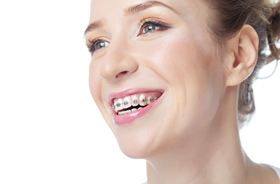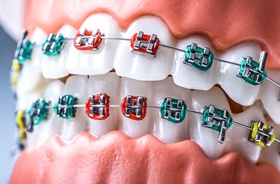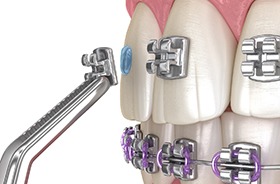
Traditional Braces – Hamden, CT
The Tried and True Path to Straighter Teeth

Are your teeth misaligned? Problems like gapped teeth, crowded teeth, and bite issues may negatively affect both your self-confidence and your oral health. Traditional braces might be able to help! They have already enabled countless patients to experience the benefits of improved dental health and more attractive facial aesthetics. Braces are suitable for individuals of practically any age, including both children and adults. Here at New Haven Dental Group in Hamden, we are proud to offer this highly effective orthodontic treatment.
Why Choose New Haven Dental Group for Traditional Braces?
- Experienced dental team
- Convenient appointment times
- Friendly, helpful staff
How Do Traditional Braces Work?

Traditional braces use brackets and wires to move the teeth. The brackets are bonded to the teeth, and a wire connects the brackets. Over time, the braces apply consistent, gentle pressure to the teeth to reposition them. In many cases, braces work alongside other orthodontic appliances to ensure to the best possible final results. The treatment time varies from patient to patient, but on average, braces take about 18 – 36 months to complete their job.
What Smile Problems Can Be Treated With Traditional Braces?

Traditional metal braces are a versatile treatment that can address most types of dental misalignment, including both mild and severe issues.
Crowded Teeth
Overlapping, crowded teeth can make oral hygiene a challenge, and they can interfere with occlusion (bite). They also negatively affect facial aesthetics. Traditional braces, potentially along with extractions, are able to relieve overcrowding.
Spaces Between Teeth
Spaces between the teeth can make speaking and chewing more difficult than they should be — and that is in addition to their unattractive appearance. Braces may be able to move the teeth and close those unsightly gaps.
Incorrect Bite Alignment
Various types of malocclusion (bad bite) can put the health of the teeth at risk and even lead to problems with the jaw joint. Traditional braces are often able to correct many kinds of malocclusion, including overbite, underbite, and crossbite.
Benefits of Traditional Braces

Some of the benefits that traditional braces offer include:
- Cost-effectiveness. Traditional metal braces are one of the most affordable methods for straightening teeth.
- Self-expression. Traditional braces allow you to choose the color of your brackets. Many younger individuals gravitate toward fun, bright colors. Adults often opt subtler hues that create a more professional impression.
- Since traditional braces are bonded directly to the teeth, you will not have to worry about forgetting to wear them.
- Predictable results. Braces are one of the most reliable methods for correcting a broad range of orthodontic problems, including issues that clear aligners might not be able to fix.
- Many patients are surprised by how comfortable modern metal braces can be.
- Once you finish your orthodontic treatment, you will enjoy all the aesthetic benefits of having straight teeth. You may notice a significant increase in your self-confidence.
Understanding the Cost of Traditional Braces

The cost of traditional braces in Hamden depends on the projected duration of treatment, as well as whether you require any additional orthodontic appliances. Our team will give you an estimate for the price of your braces when you attend your consultation. We will also talk about payment options with you. Your insurance might cover a portion of the cost of your treatment. We also periodically offer promotional pricing on orthodontia.
Factors That Affect the Cost of Traditional Braces

The price of traditional braces depends on a few factors, including:
- The severity of your dental misalignment. Logically, more severe and complex misalignment takes longer to correct and requires more appointments than simpler cases. This leads to a higher overall cost.
- Your age. The teeth of adults tend to move more slowly than those of younger patients, so more mature individuals may end up paying more.
- Compliance with treatment guidelines. Wearing rubber bands and accessories as directed, as well as being careful to avoid damage to your braces, can help you to avoid extra fees.
Professional Braces vs. DIY Braces: Which Costs More?

You may have seen some DIY orthodontic “hacks” on social media websites or other platforms. Such tricks might involve using household items, like paperclips, fishing line, and dental floss, to move the teeth. While you might be tempted to try DIY methods on your own teeth in order to save money, extreme caution should be exercised for several reasons:
- DIY braces may end up moving teeth in the wrong direction, worsening your dental misalignment and costing you more money in the long run.
- Some DIY methods recommend the use of toxic substances in the mouth, such as superglue.
- You could accidentally cause permanent damage to your teeth or gums.
Does Dental Insurance Cover Braces?

A handful dental insurance policies cover braces. In some cases, only minors may be eligible for coverage. For a number of higher-end plans, however, adult orthodontia may also be covered. When braces are covered, you can usually expect insurance to pay for about half of their cost, up to the amount of a policy’s orthodontic maximum. If your plan does not apply to braces, you might use your flexible spending account or healthcare savings account to lower your out-of-pocket costs instead.
Options for Making Braces Affordable

In addition to helping you with insurance, our practice offers a few provisions that might make your braces treatment easier to afford:
- You may qualify for low-interest financing from a third party, such as CareCredit.
- We periodically offer special pricing on braces. For example, you may be able to get one month free.
- Essential Dental Plan. This discount plan provides reduced fees on most of the services available in our practice.
To learn more about how we can help you manage the cost of a straighter smile, get in touch with us today to schedule a consultation.
Traditional Braces FAQs

When you are ready to get started with braces in Hamden, our team is prepared to assist you. In the meantime, though, you may be curious about this treatment. To help you find answers to your most pressing questions, we have put together the following brief list of FAQs. If you do not see the information you were looking for, give us a call. We enjoy helping our patients be well-informed about all of their treatment options.
Am I Too Old to Get Braces?
While it is normal for braces to be thought of as a treatment for teens and children, they are actually quite common among adults. There is no upper age limit for braces, and treatment for younger and older patients is basically the same. The biggest difference is that it may take slightly longer for the orthodontia to complete its work because adults’ teeth tend to move more slowly than those of younger individuals.
Braces are popular among adults because they are quite cost-effective. Plus, convenient financing is available to make them accessible for most families’ budgets.
Can I Get Traditional Braces on Just My Top or Bottom Teeth?
At first, getting braces on just the top or bottom teeth may seem like a convenient way to save money. However, it is rarely possible to perform single-arch treatment. When the teeth in either the upper or lower jaw move, the teeth in the other jaw should move as well. If they do not, bite alignment problems could easily result. Bite problems, in turn, can contribute to issues like TMJ disorder, chewing difficulty, and worsened facial aesthetics.
What Happens After You Get Your Braces Off?
Teeth have a sort of “memory,” so once your braces come off, your smile will want to drift back to its original position. Fortunately, this can be prevented with a retainer. A retainer is a small, custom appliance that applies slight pressure to the teeth in order to keep them in place. If your retainer is removable, you should be diligent about wearing it for 20 – 22 hours each day for at least a few months. Later, you might be able to progress to wearing it only a few nights each week.
How Long Do Traditional Braces Take?
The average treatment time with braces is 18 – 36 months. How long it takes to straighten your teeth will depend on a few factors, including:
- The severity of your dental misalignment. Logically, more complex issues take longer to correct.
- Your age. Treatment times tend to be slightly longer for adults, whose teeth move more slowly than those of younger people.
- Compliance with treatment instructions. Failing to use your accessories or making other missteps during treatment could delay your final results.
Do Traditional Braces Hurt?
You may experience temporary discomfort when we first place your braces in Hamden or adjust them. This mild soreness typically lasts a few days and is a sign that your teeth are moving into their new positions. You can take over-the-counter pain relief as needed. Eating a soft, mild diet can also be helpful.
You can expect the discomfort to fade as your mouth adjusts. However, if the pain persists longer than a few days or becomes more intense, you should contact our team right away so we can assist you.
What Can You Not Eat with Traditional Braces?
There are certain foods you should avoid while wearing traditional braces to prevent damage. Hard, sticky, or chewy foods may break brackets, bend wires, or irritate your oral tissues. Here are some specific examples of foods that you should not consume:
- Candies like gum, caramel, and taffy
- Popcorn and hard candy
- Ice and nuts
- Chips
- Pizza crusts and other hard breads
As you embark on your treatment journey, our team can provide more detailed directions on what you should and should not eat. You are also always free to ask questions about how you can design your diet to work well with your orthodontic treatment.
Can You Whiten Your Teeth While Wearing Braces?
It is best not to use whitening products while you have braces. That is simply because whitening products cannot reach areas covered by brackets, which may lead to uneven coloration on your teeth. However, it should be fine to use a mild whitening toothpaste to reduce new surface stains.
After your braces have been removed, you might choose to get your teeth professionally whitened. However, we advise a waiting period of six months or so. This allows time for any braces-related sensitivity to wear off. Plus, you are likely to find that any discoloration related to your braces will fade over time.
Why Do My Teeth Feel Loose with Braces?
Your teeth are not directly set in your jawbone. Rather, they are attached to the surrounding bone via stretchy tissues known as ligaments. As your teeth move, your bone has to create space for them, so the ligaments will have a bit more wiggle room until your jawbone finishes its remodeling process.
Therefore, a degree of looseness is to be expected during orthodontic treatment. However, if your teeth ever feel overly loose, or you have any concerns related to their movements, you are welcome to call us.
Can Traditional Braces Fix TMJ Disorder?
TMJ disorder (TMD) can have a variety of causes, one of which is a misaligned bite. As your teeth move into their proper positions, you may experience reduced stress on your jaw joints and the surrounding muscles. Consequently, you could find that your TMD symptoms begin to subside or even that they disappear altogether.
Of course, it is important to keep in mind that each case of TMD is unique, and you may respond to different therapies than other patients. There are a variety of ways to address this condition, and they are suited for differing circumstances.